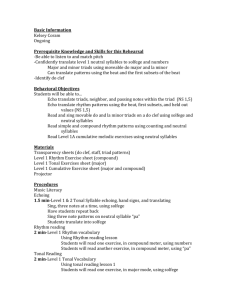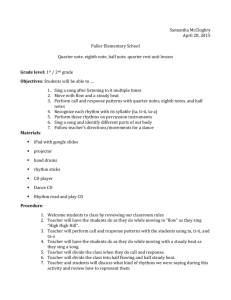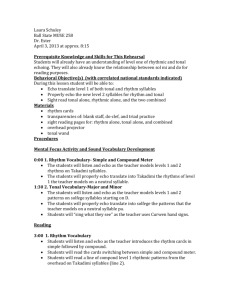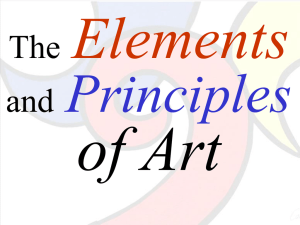File
advertisement
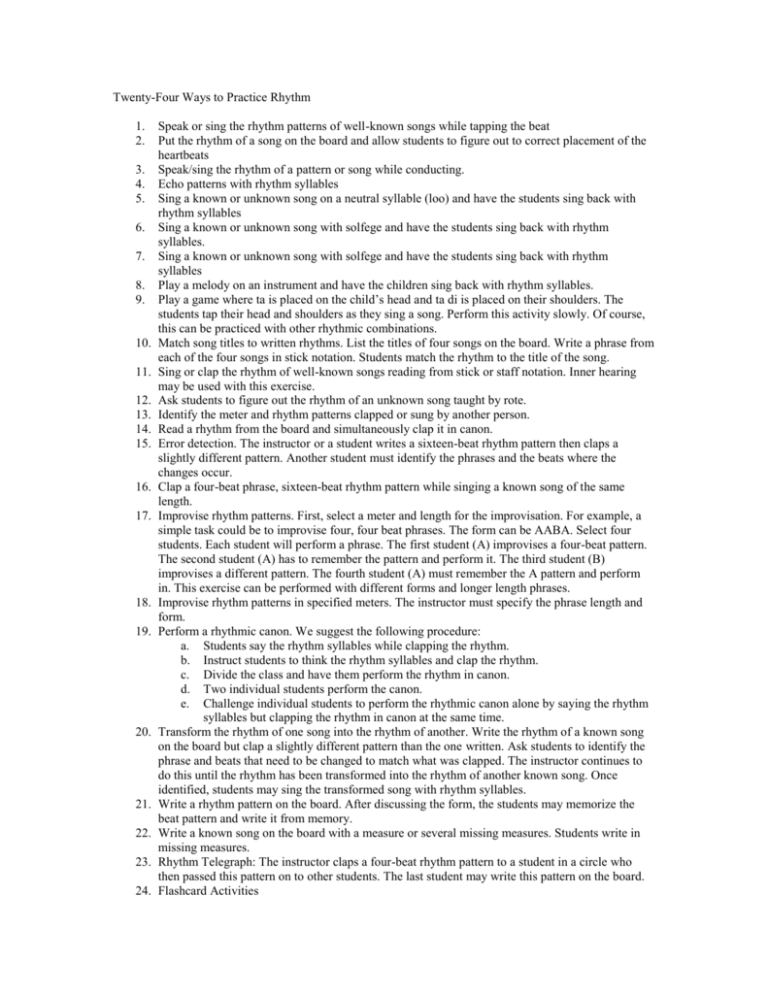
Twenty-Four Ways to Practice Rhythm 1. 2. 3. 4. 5. 6. 7. 8. 9. 10. 11. 12. 13. 14. 15. 16. 17. 18. 19. 20. 21. 22. 23. 24. Speak or sing the rhythm patterns of well-known songs while tapping the beat Put the rhythm of a song on the board and allow students to figure out to correct placement of the heartbeats Speak/sing the rhythm of a pattern or song while conducting. Echo patterns with rhythm syllables Sing a known or unknown song on a neutral syllable (loo) and have the students sing back with rhythm syllables Sing a known or unknown song with solfege and have the students sing back with rhythm syllables. Sing a known or unknown song with solfege and have the students sing back with rhythm syllables Play a melody on an instrument and have the children sing back with rhythm syllables. Play a game where ta is placed on the child’s head and ta di is placed on their shoulders. The students tap their head and shoulders as they sing a song. Perform this activity slowly. Of course, this can be practiced with other rhythmic combinations. Match song titles to written rhythms. List the titles of four songs on the board. Write a phrase from each of the four songs in stick notation. Students match the rhythm to the title of the song. Sing or clap the rhythm of well-known songs reading from stick or staff notation. Inner hearing may be used with this exercise. Ask students to figure out the rhythm of an unknown song taught by rote. Identify the meter and rhythm patterns clapped or sung by another person. Read a rhythm from the board and simultaneously clap it in canon. Error detection. The instructor or a student writes a sixteen-beat rhythm pattern then claps a slightly different pattern. Another student must identify the phrases and the beats where the changes occur. Clap a four-beat phrase, sixteen-beat rhythm pattern while singing a known song of the same length. Improvise rhythm patterns. First, select a meter and length for the improvisation. For example, a simple task could be to improvise four, four beat phrases. The form can be AABA. Select four students. Each student will perform a phrase. The first student (A) improvises a four-beat pattern. The second student (A) has to remember the pattern and perform it. The third student (B) improvises a different pattern. The fourth student (A) must remember the A pattern and perform in. This exercise can be performed with different forms and longer length phrases. Improvise rhythm patterns in specified meters. The instructor must specify the phrase length and form. Perform a rhythmic canon. We suggest the following procedure: a. Students say the rhythm syllables while clapping the rhythm. b. Instruct students to think the rhythm syllables and clap the rhythm. c. Divide the class and have them perform the rhythm in canon. d. Two individual students perform the canon. e. Challenge individual students to perform the rhythmic canon alone by saying the rhythm syllables but clapping the rhythm in canon at the same time. Transform the rhythm of one song into the rhythm of another. Write the rhythm of a known song on the board but clap a slightly different pattern than the one written. Ask students to identify the phrase and beats that need to be changed to match what was clapped. The instructor continues to do this until the rhythm has been transformed into the rhythm of another known song. Once identified, students may sing the transformed song with rhythm syllables. Write a rhythm pattern on the board. After discussing the form, the students may memorize the beat pattern and write it from memory. Write a known song on the board with a measure or several missing measures. Students write in missing measures. Rhythm Telegraph: The instructor claps a four-beat rhythm pattern to a student in a circle who then passed this pattern on to other students. The last student may write this pattern on the board. Flashcard Activities a. b. c. d. e. f. Read several flashcards using four beat-patterns written in traditional notation in succession Place the cards on the ledge of the chalkboard and perform them in order. Change the order of the cards. Have individual students read patterns by changing the order of the cards. Gradually arrange the order of the cards to move from one song to another in a lesson. A card may be removed and an individual student may improvise a rhythm to replace the missing pattern. By extending the number of phrases involved in this activity, different forms may be practiced. Have a student draw a rhythm card from a box. Another student may tell her how to perform the rhythm. The class may echo the rhythm. Read a series of rhythm flashcards in succession; have the class read them in succession; or have students read them backwards. Ask students to rearrange a series of flash cards to create a known song. Students memorize four, eight, twelve, or sixteen beat patterns from flash cards and sing back with rhythm syllables or write the memorized patterns using stick notation. Eighteen Ways to Practice Melody 1. 2. 3. 4. 5. 6. 7. 8. 9. 10. 11. 12. 13. 14. 15. 16. 17. 18. Children’s Piano. Each child becomes a musical pitch and takes a place in order from high to low so that the instructor can play the piano by pointing to each child to sing the pitch. Arranging students in order of pitch is also a way to practice singing intervals. Sing known melodies or phrases with solfege syllables and hand signs Sing with solfege syllables and conduct. Sing a known song with solfege syllables and hand signs reading stick or staff notation Sing a known song or phrase with solfege syllables and/or leter names and hand signs and have the students echo Sing a known song with text and have the students echo with hand signs and solfege syllables and/or letter names. Show a melody with hand signs or finger staff and have the students sing with hand signs and solfege syllables and/or letter names Hum a known song or phrase and have the students echo back with hand signs and solfege syallbles and/or letter names Point to a melody on the staff or tone ladder and have the students sing with had signs and solfege syllables or letter names. Sing a phrase with rhythm syllables and have the students echo sing the phrase with solfege syllables or letter names Play a melody on recorder and have the students sing with solfege syllables and/or letter names. Show a pattern with hand signs or point to a tone chart or tone ladder. Ask an individual to sing the pattern. Sing a melody or play a melody on piano and have the students sing in canon with solfege syllables, letter names, or rhythm syllables. Perform a three part canon in the following manner. The instructor plays a melody on piano, group one signs in canon after two measures, and group two sings in canon with group one Students read a music example with solfege syllables; at a given signal from the instructor, students switch to singing with letter names Divide class into two groups; each group reads a pentatonic melody of the same phrase structure and phrase length simultaneously Play a melody on piano and have the students play it back immediately Sing a Melody in retrograde.
